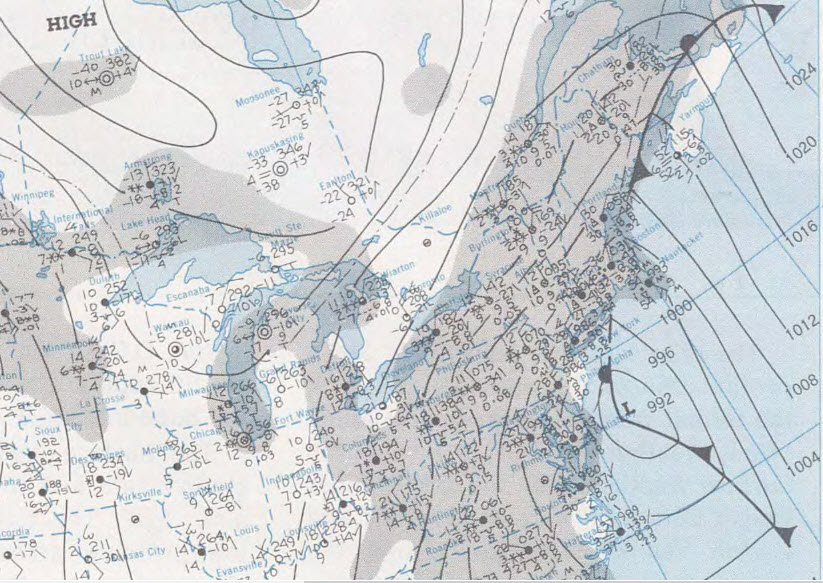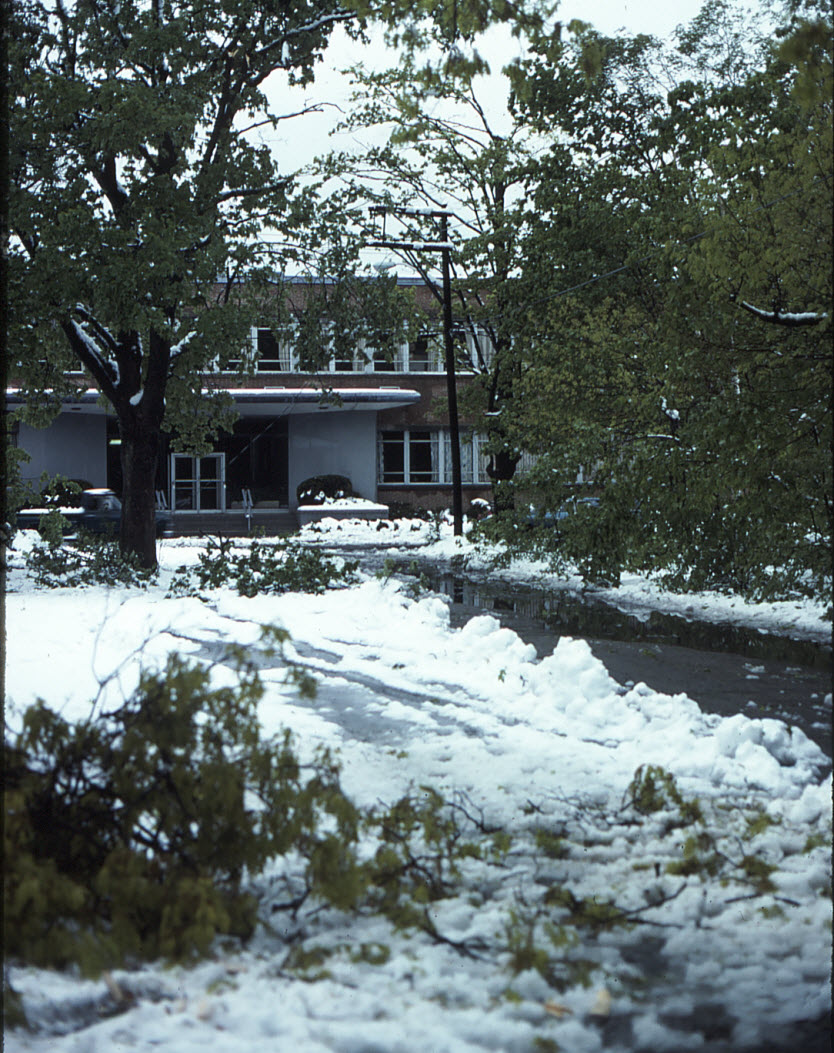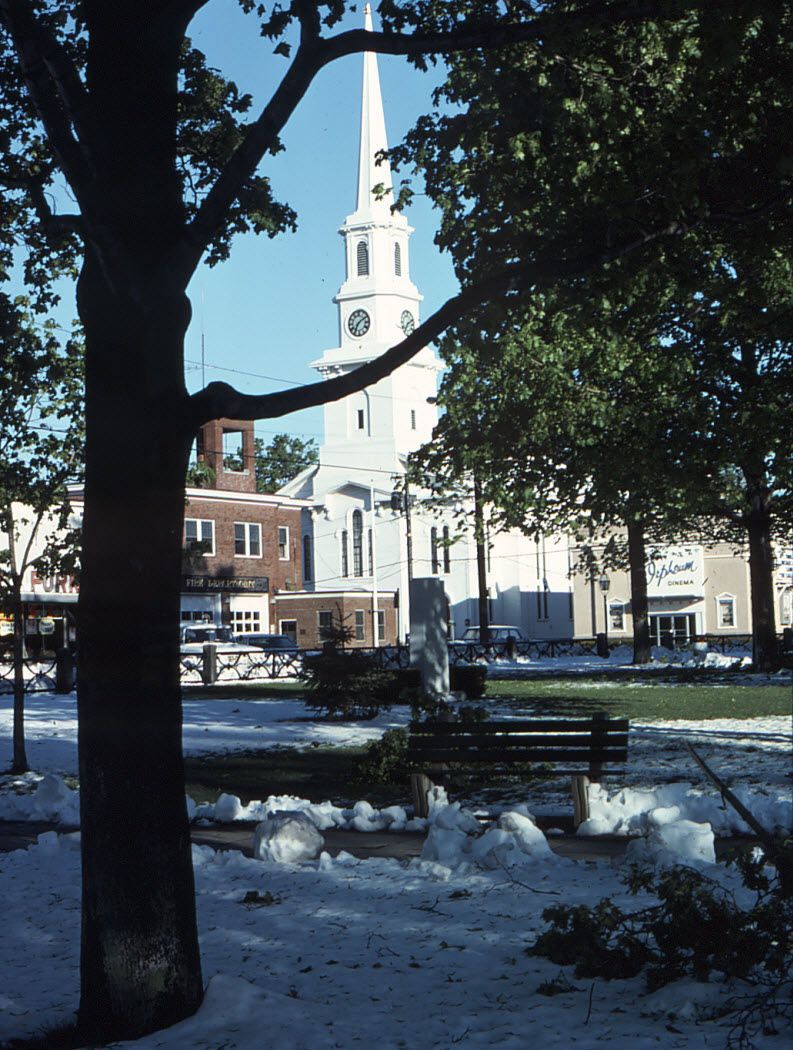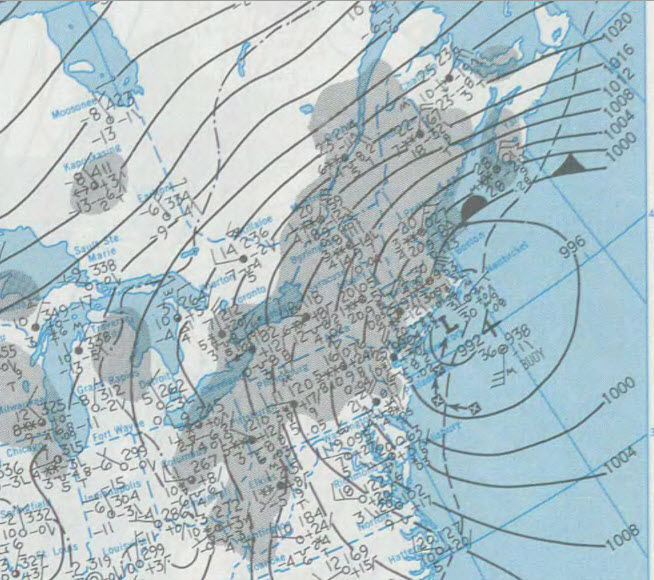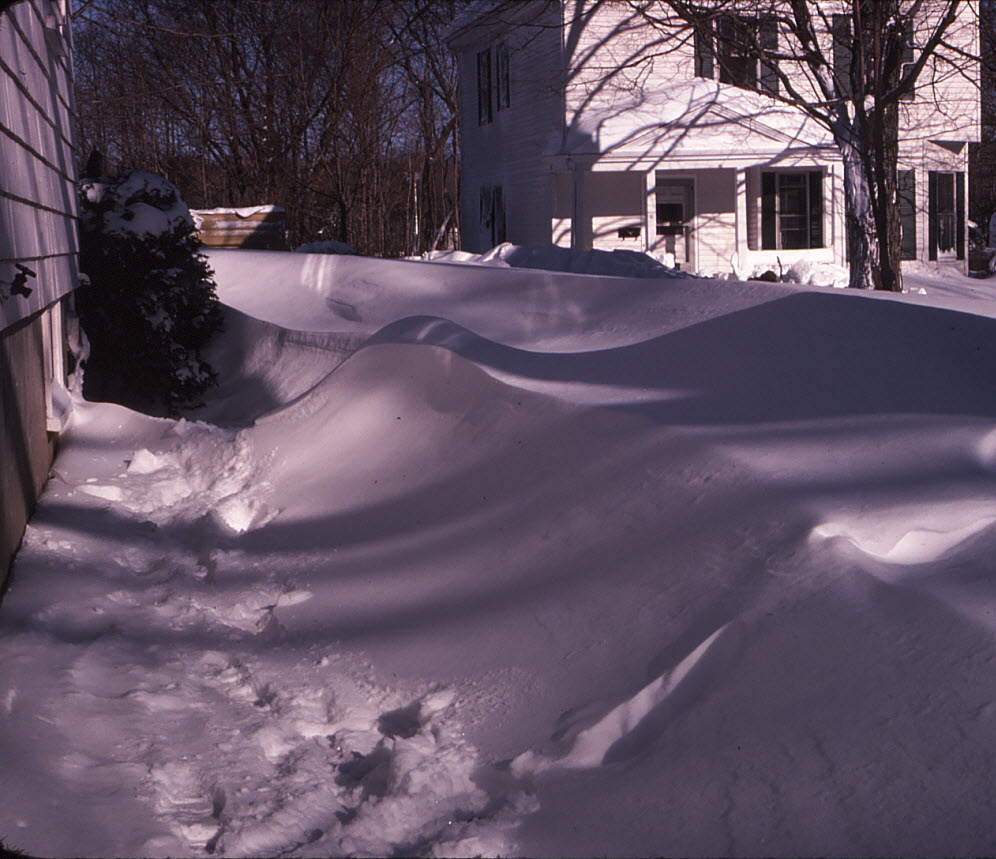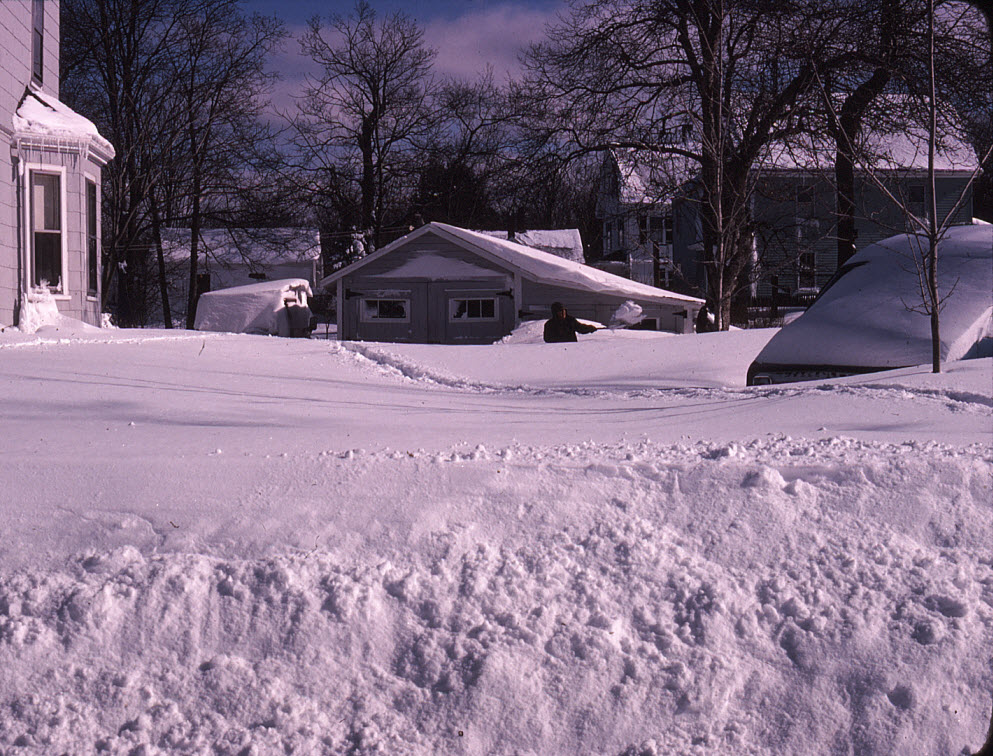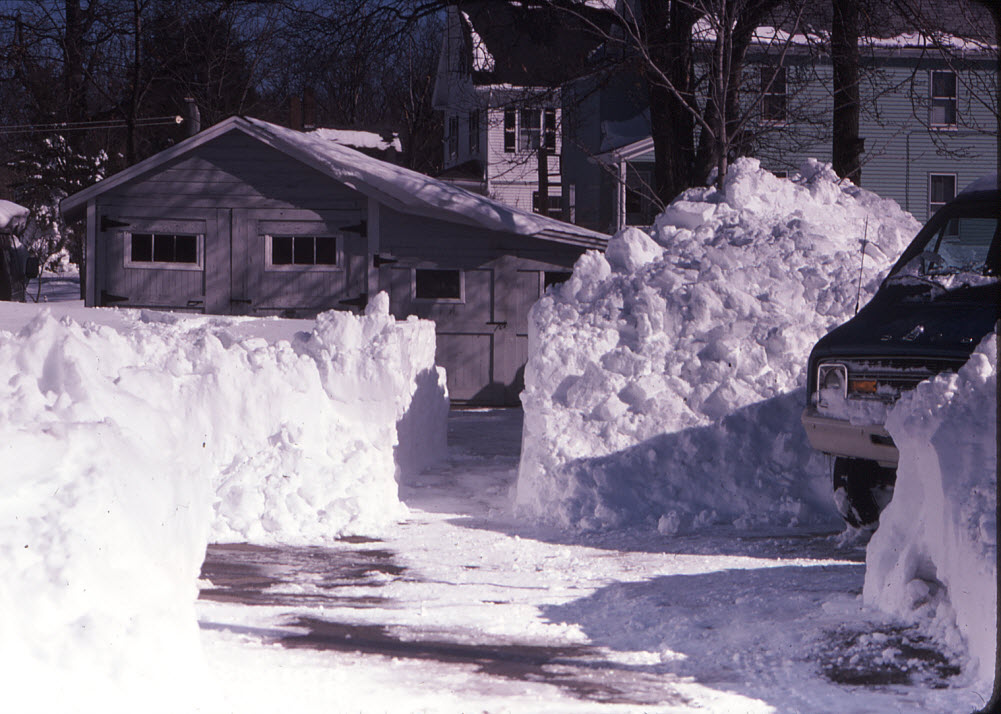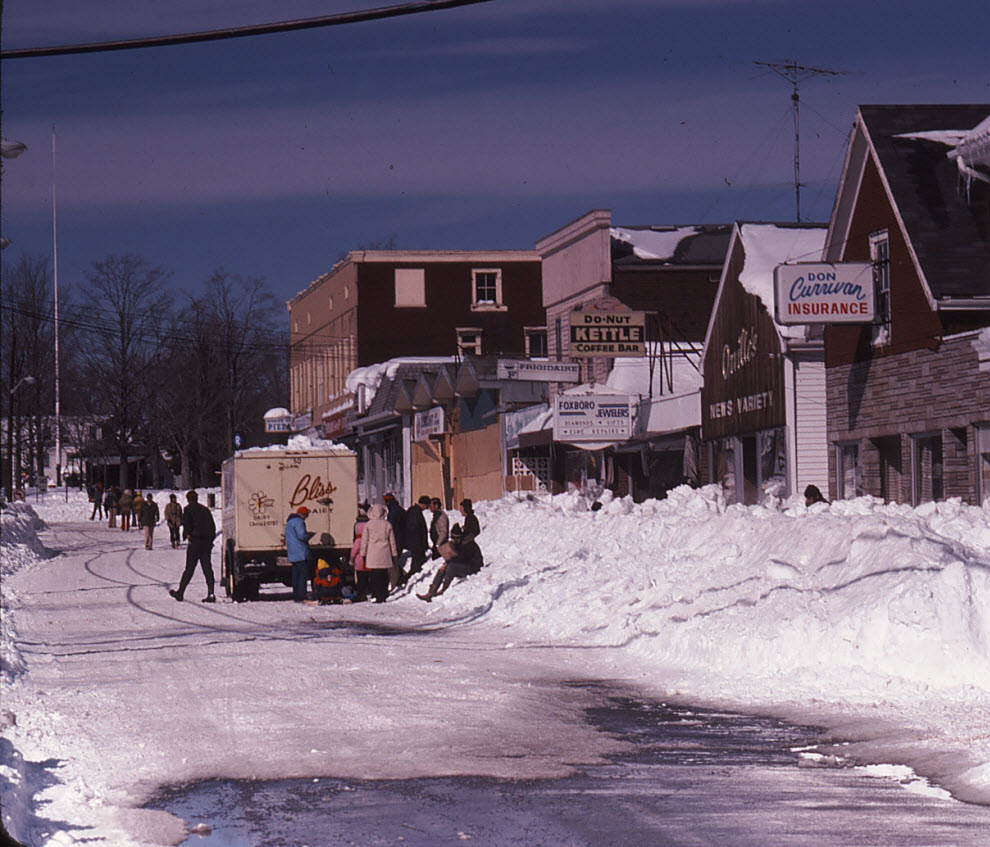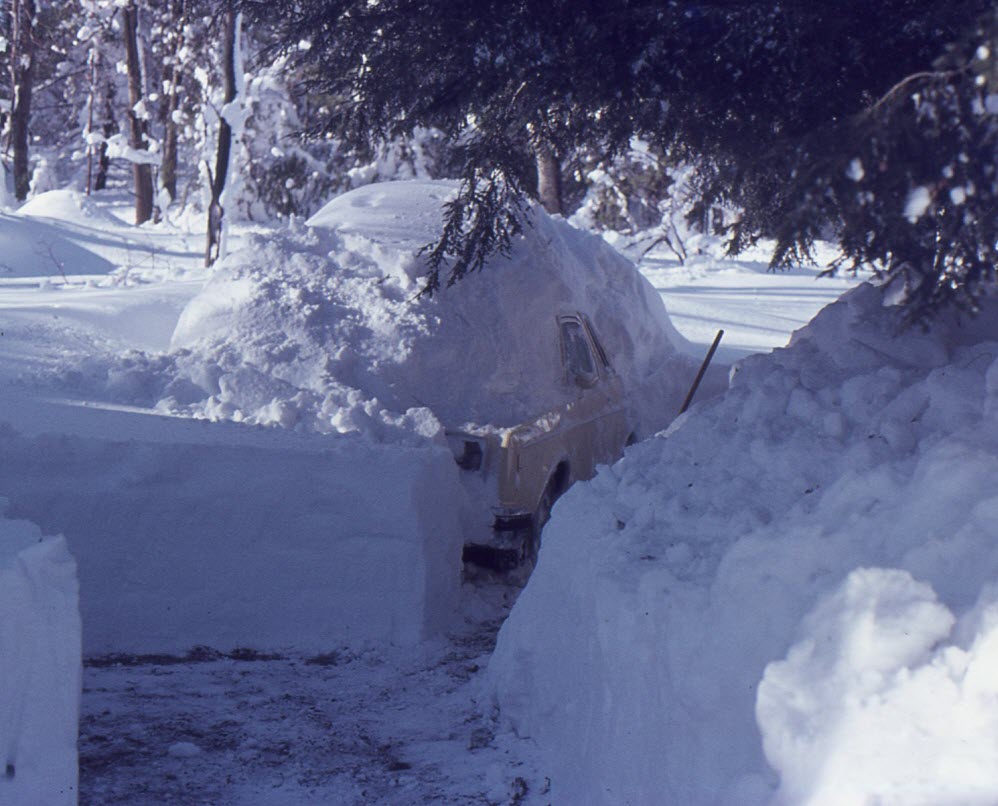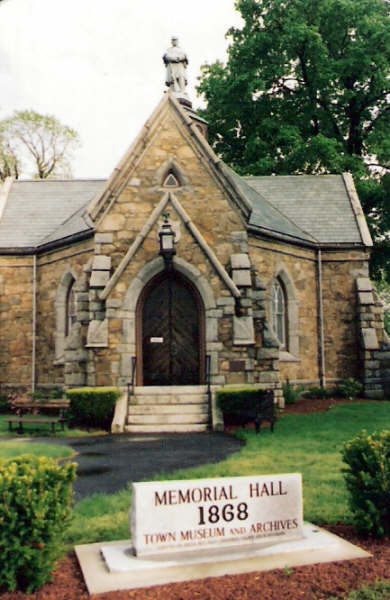
|
Society & Commission
|
|
Our History
|
|
KCH House
|
Significant Weather Events in Foxborough History
Here we plan to discuss some of the significant weather events in recent history. Please check back for the addition of other weather events to this page.
The Ice Storm of 1973
It was Sunday December 16th and something had been missing that fall in the greater Foxborough area: snow. It was the latest first snowfall recorded in Massachusetts, but things were about to change.
In Canada a high pressure system pushed cold weather southward and temperatures on the early morning of December 16th averaged in the mid to upper 20s in Massachusetts. On the coast a low pressure system moved over the Atlantic ocean near Georgia, started to race to the northeast, and joined with an area of precipitation that had moved in from the Ohio River Valley. The storm brought mild upper level weather over regions that had colder temperatures near the ground.
By the evening of December 16 in Foxborough, rain moved into the area and flurries mixed in during the overnight hours. To the south, as the storm moved up the coast to the northeast, cold weather quickly pressed in behind it.
Heavy precipitation moved in later that night during the storm that would total 3.49 inches of rain before it was done. Warm weather won the fight during the early part of the storm while cold weather won during others. By 4AM Monday morning school officials decided that the rainy mix was not bad enough to cancel school. Within hours, the ice worsened, knocking down small limbs. At 7:46 AM the first call came in for wires down on Chestnut Street. That was followed by a call for wires down on North Street at 8:09AM and wires down on Mechanic Street at 8:47AM. Streets in some areas began to flood and before the day was out the Lewis, Burrell, and Ahern schools had all lost power.
The fire department started assisting homeowners with flooded basements while the police department tracked fallen limbs, power outages, and downed wires. Civil Defense Director Albert O. Keyworth moved into emergency preparations and the Robinson Hill School was opened for citizens in need of shelter. The battle between warm air and cold waged on, but as the storm passed directly over Massachusetts it carried milder weather with it. Within a 6 minute period, temperatures shot from 38 to 52 degrees.
As the storm wound down on Tuesday, a cold front moved in and temperatures quickly fell into the freezing territory. The average temperature on Tuesday was a mere 12 degrees. As residents pumped water from their basements it soon froze on local roadways prompting a quick response from sanding crews. Luckily, power was restored to most residents by the end of Tuesday, but Mass Electric noted that Foxborough was the hardest hit area in their service territory. It was a blessing that the area regained power on Tuesday as by Wednesday morning, South Foxboro reached 0 degrees.
While most of Foxborough considered the storm over within 48 hours, Connecticut and Rhode Island were not as lucky. Power loss was widespread in both states as ice was more prevalent and coated tree limbs in a storm that residents remember decades later. In Connecticut one third of all homes were without power for at least two days and some residents had no power for a week. In the Washington D.C. area 8-10 inches of snow fell which to this day places the storm in the top five list of December snowfalls in the region.
If you are interested in reading about the storm damage in Connecticut, a blog by Kurt Blumenau details the storm as described by his grandparents who lived in Stamford, Connecticut at the time.
You can view his blog entry on the storm by clicking this link.
Michael also has photos of the storm damage in his boyhood hometown of Weston, Connecticut. His photos show the family roughing it after power was out and they relied on bottled water, sterno, a camp stove, and fireplace to keep fed and warm. His photos are available starting here. (click the right arrow to view them all.) His blog describing the event can be read here.
Last, there is a collection of 1973 ice storm photos presented in this youtube video.
The ice storm of 1973 served as a backdrop in Rick Moody's novel "The Ice Storm" which was later made into a feature film by Ang Lee and James Schamus.
The Foxborough Historical Commission has no photos of The Ice Storm of 1973. Please consider donating any Foxborough photo you have of this weather event.
The May 9 and 10 Snowstorm of 1977
High temperatures on the weekend of May 7 and 8 of 1977 ranged from the mid 70s to low 80s in the area. Historical Commission member Emelie Bonin recalls attending her son’s First Communion at St. Mary’s on Sunday May 8th on what was a beautiful spring day. In the family photo shot in front of the church many attendees wore short sleeves, but a day later she and her family sat in a cold powerless house.
The surprising twist in this event was that weather across the northern United States was temperate. Even Caribou Maine reached 50 degrees on May 8th. A low pressure system in Canada between Lake Huron and the southern tip of Hudson Bay headed directly for New York City and was followed by a high pressure system carrying winter-like temperatures. By Monday morning the low pressure system was just to the south of the Connecticut/Rhode Island border and started to pull colder air in from the North.
Temperatures fell steadily from the mid 40s on Monday morning into the 30s by late morning and snowflakes soon started mixing in with rain. As temperatures continued to drop during the afternoon a heavy wet snow soon stuck to surfaces that were wet with rain. Neither colder temperatures that would have turned precipitation to a lighter snow nor warmer Atlantic temperatures that could have turned precipitation to rain ever arrived. Instead, the storm maintained a fine balancing act with temperatures at or just above freezing and the snow continued.
Many trees had their leaves by early May and branches soon bent and broke under the weight of the heavy wet snow. By 7PM that evening large sections of town were without power. The Town Meeting was opened and immediately adjourned before an empty and dark high school auditorium. Town Hall and the Igo Administration Center were opened as emergency shelters for residents without power or heat. Plowing was initially delayed as plows had already been removed from highway department trucks for the season and workers had to first remount plows to the trucks before they could begin clearing local roads.
The fire department, too, had been surprised by the winter weather and had parked vehicles outside so that a new concrete apron could be installed at the station. When the first fire call came in from Hallowell Road firefighters were forced to respond with snow covered equipment. As residents pressed their fireplaces or stoves into duty to help keep warm firefighters also responded to fires on Lakeview Road, Chestnut Street, and Route One. Meanwhile members of the police answered 70 calls for downed limbs and power outages. Once highway crews plowed the roads they began clearing downed limbs so that Massachusetts Electric could begin the process of restoring power.
The heavy wet snow wound down on Tuesday and when it was over 5 and one half inches had fallen in Foxborough. School was cancelled on both Tuesday and Wednesday. Dean Swift, owner of the Quaker Hill Restaurant on West Street, provided free spaghetti dinners to all police, fire, highway department crews, and senior citizens starting on Tuesday afternoon. With the help of his children Joanne, David, and Mary Ann, they continued serving spaghetti until midnight on Tuesday and then switched to bacon and eggs for Wednesday morning. All food was served free of charge. Since the restaurant was without power it was lit by candle including by a handmade candelabra provided by Cliff Curry.
Mass Electric crews worked 18 hour shifts and had restored power to most of the town by Wednesday morning. More isolated areas in town, however, were still without power when the Foxboro Reporter went to press on Wednesday night. High temperatures slowly rebounded to 49 on Wednesday, 58 on Thursday, and then almost 80 on Friday.
Here we present three images from the Holmberg collection. Note a single uncovered tulip in the foreground and damaged maple tree in the background.
A Foxboro Company entrance just after the storm ended.
A view of the common a day or two after the storm.
The Blizzard of 1978
By February 5th bitter cold weather had pushed down from Canada deep into the United States (Atlanta Georgia barely reached 20 degrees that day) when a low pressure system developed off the coast of South Carolina and started heading towards New England. Snow arrived in the area on Monday February 6th and high pressure near Greenland prevented the storm from rapidly passing up the coast. The storm featured hurricane-force winds while a new moon brought astronomical high tides which devastated some coastal communities. It was time to hunker down and ride this one out.
Snow started falling in Foxboro on Monday shortly before 11AM but the situation devolved quickly as heavy snow bands mixed with high winds soon made driving treacherous. By mid afternoon the first report of a stranded vehicle reached the police department. By 4:30 police were logging calls for disabled vehicles every five to ten minutes. At 5PM State Police brought the first load of stranded motorists removed from cars on routes 95 and 495 to Foxboro and they were placed in emergency shelters that had been opened at Saint Marks and Bethany Churches.
Civil Defense (CD) headquarters were established in the Town Hall to help coordinate storm related efforts across town. By 6PM the first police cruiser became stuck in the snow and the police were fielding disabled vehicle calls at the rate of one per minute. Calls too were coming from anxious relatives looking for information on travelers that were presumed stranded somewhere along route 95; Without knowing where to look they called each town along the route home. CD maintained a list of stranded motorists that were sheltered locally to aid in the search efforts. Appearing on WHDH radio between 8 and 10PM for his monthly segment Governor Michael Dukakis declared a state of emergency thereby banning all but essential travel on the state's roads.
Efforts to keep side roads plowed were soon scaled back and later abandoned as crews worked non-stop to keep as many main roads as possible open for emergency vehicles. Tow trucks were able to remove stranded cars at the start of the day but at 11PM the last truck in service broke down and no more cars could be removed. By midnight the police department had none of their own cruisers on the local roadways. When the Fire Department attempted to reach Spring Street to assist a boy with a hand injury the ambulance could not reach the home and the boy was brought to the ambulance via toboggan. Firefighters later arrived to a call on Centennial Court on snowmobile and in another instance carried needed oxygen through waist high snow.
Members of the Cannonball Chapter, Brothers of The Brush, and the local chapter of the Massachusetts Four Wheelers Association offered their services to the police and Civil Defense. Overnight residents with snowmobiles started rescuing stranded drivers and ferrying them to the local shelters. When five drivers elected to stay with their vehicles to protect cargo, the snowmobile drivers brought them food during the remainder of the storm. A total of 52 motorists were brought to shelters and cared for locally.
As Tuesday February 7th dawned the snow and winds continued unabated. Residents with four-wheel drive vehicles offered them to Civil Defense. CD in turn coordinated requests to bring essential employees such as health care workers to their job, transport residents seeking non-emergency medical treatment, perform wellness checks, and deliver needed prescriptions to residents. During the storm CD coordinated the activities of as many as 42 vehicles.
Owner Dean Swift opened the Quaker Hill Restaurant on Tuesday to cook meals for the police and highway departments, CD volunteers and Massachusetts Electric workers and provided meals for those sheltered at Saint Marks and Bethany Churches. One of the vehicles stranded in town was a milk truck—local officials removed the milk supply and dispatched it to the local shelters. Volunteers later distributed part of this milk and 500 loaves of bread from Mother’s Bakery on Railroad Avenue to local residents at the VFW Hall in East Foxboro.
Heavy snow and wind continued all day Tuesday but finally ceased by Wednesday morning. By the time it was over approximately 30 inches of snow had fallen. Perhaps the most significant storm damage occurred at the Lewis school where the roofs of two classrooms collapsed under the weight of drifting snow. The school was shuttered for the remainder of the school year with students being relocated to the Igo Building.
Area roadways were closed for days (except for essential personnel) while operations to remove stranded cars from highways and then clear the snow were undertaken. In Foxboro the main roads were opened relatively soon but many side streets remained unplowed until Friday evening. In an effort to prevent what happened at the Lewis school, the town hired workers to clear the snow from all school buildings and would not allow students to return until the structures were inspected. When schools did reopen bus drivers were asked to pick up any students walking to school since it was impossible to clear the sidewalks and pedestrians were forced to walk along streets.
Evidence of the drifting experienced in the storm where virtually no snow is up against the foundation but drifts of two and three feet are just off to the right.
The start of a long effort for one home owner.
The same driveway later where just enough room has been cleared to navigate and pull the van out of the driveway.
A view of Central Street after the storm: Residents approach the Bliss Dairy truck to pick up needed supplies.
Foxboro Company Europe employee Eugene Jeurissen spent one year in Foxboro with his family starting in January of 1978. Vin Igo warned him that a lot of snow was coming and Euguene shared this image of the efforts to reclaim the car at their Granite Street home.
Thanks to Glenn Field and Hayden Frank of the National Weather Service for providing me with access to historical weather maps for the weather events described on this page.
This page was last updated 4/4/2018
Images appearing on this website may not be reproduced in any manner without express written permission from the Foxborough Historical Commission.
